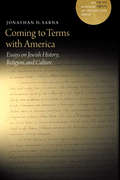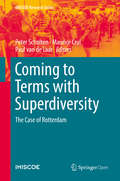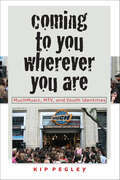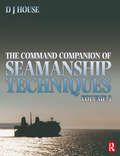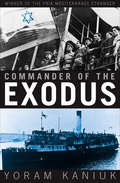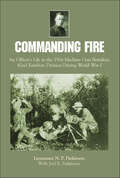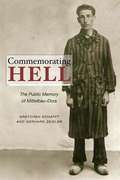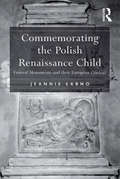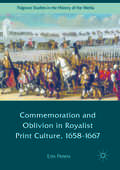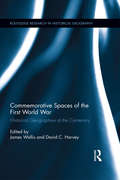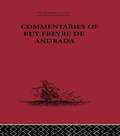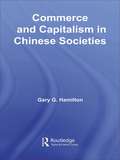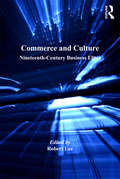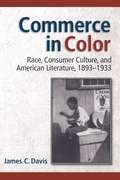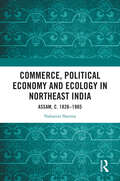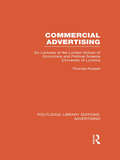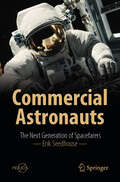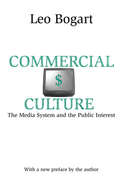- Table View
- List View
Coming to Terms with America: Essays on Jewish History, Religion, and Culture (A JPS Scholar of Distinction Book)
by Jonathan D. SarnaComing to Terms with America examines how Jews have long &“straddled two civilizations,&” endeavoring to be both Jewish and American at once, from the American Revolution to today. In fifteen engaging essays, Jonathan D. Sarna investigates the many facets of the Jewish-American encounter—what Jews have borrowed from their surroundings, what they have resisted, what they have synthesized, and what they have subverted. Part I surveys how Jews first worked to reconcile Judaism with the country&’s new democratic ethos and to reconcile their faith-based culture with local metropolitan cultures. Part II analyzes religio-cultural initiatives, many spearheaded by women, and the ongoing tensions between Jewish scholars (who pore over traditional Jewish sources) and activists (who are concerned with applying them). Part III appraises Jewish-Christian relations: &“collisions&” within the public square and over church-state separation. Originally written over the span of forty years, many of these essays are considered classics in the field, and several remain fixtures of American Jewish history syllabi. Others appeared in fairly obscure venues and will be discovered here anew. Together, these essays—newly updated for this volume—cull the finest thinking of one of American Jewry&’s finest historians.
Coming to Terms with Chance: Engaging Rational Discrimination and Cumulative Disadvantage
by Oscar H. GandyThe application of probability and statistics to an ever-widening number of life-decisions serves to reproduce, reinforce, and widen disparities in the quality of life that different groups of people can enjoy. As a critical technology assessment, the ways in which bad luck early in life increase the probability that hardship and loss will accumulate across the life course are illustrated. Analysis shows the ways in which individual decisions, informed by statistical models, shape the opportunities people face in both market and non-market environments. Ultimately, this book challenges the actuarial logic and instrumental rationalism that drives public policy and emphasizes the role that the mass media play in justifying its expanded use. Although its arguments and examples take as their primary emphasis the ways in which these decision systems affect the life chances of African-Americans, the findings are also applicable to a broad range of groups burdened by discrimination.
Coming to Terms with Policing: Perspectives on Policy (Routledge Library Editions: Police and Policing)
by David J. Smith Rod MorganIn the late 1980s, the role of the police and their accountability to the community had been at the centre of much debate. Originally published in 1989, this important collection of original essays from the leading independent academic researchers on the police in Britain addresses the major issues in this debate. How far police behaviour is shaped by law; what the public expect of the police; how the police handle race relations; and how the police effectiveness can best be measured, are discussed in the light of the latest research. The central focus of the volume is the notion of ‘policing by consent’ and the way this is interpreted in practice. The essays range from basic analyses of what the police do to major evaluations of recent policy initiatives, such as neighbourhood watch. The contributors discuss a range of issues, from new programmes for police training to the role of chief constables. Written in a form accessible to students of policing and police officers, Coming to Terms with Policing sheds light on trends at the time and suggests new directions for policing policy.
Coming to Terms with Superdiversity: The Case of Rotterdam (IMISCOE Research Series)
by Peter Scholten Maurice Crul Paul van de LaarThis open access book discusses Rotterdam as clear example of a superdiverse city that is only reluctantly coming to terms with this new reality. Rotterdam, as is true for many post-industrial cities, has seen a considerable backlash against migration and diversity: the populist party Leefbaar Rotterdam of the late Pim Fortuyn is already for many years the largest party in the city. At the same time Rotterdam has become a majority minority city where the people of Dutch descent have become a numerical minority themselves. The book explores how Rotterdam is coming to terms with superdiversity, by an analysis of its migration history of the city, the composition of the migrant population and the Dutch working class population, local politics and by a comparison with Amsterdam and other cities. As such it contributes to a better understanding not just of how and why super-diverse cities emerge but also how and why the reaction to a super-diverse reality can be so different. By focusing on different aspects of superdiversity, coming from different angles and various disciplinary backgrounds, this book will be of interest to students and scholars in migration, policy sciences, urban studies and urban sociology, as well as policymakers and the broader public.
Coming to You Wherever You Are: MuchMusic, MTV, and Youth Identities
by Kip PegleyMTV Networks is the undisputed international music video gatekeeper, with stations from Australia to India, Russia to Brazil. Canada is one of the few countries to resist its global reach. Although the network has launched "MTV Canada" with an affiliate, that station limits its offerings primarily to talk shows and lifestyle programming. Many Canadians regard the Toronto-based MuchMusic as the nation's important domestic source of music videos—substantially different from, and superior to, American-based MTV. In her new study of the two music channels and their different cultures, Kip Pegley compares the musical and extra-musical content of MuchMusic and MTV, and examines how the stations construct their two distinct identities. Moving beyond analysis of individual videos, Pegley looks at the overall programming of each station, uncovers the well-hidden matrixes of power that dictate both which performers appear and what genres get the most airtime, and delves into how ideas of gender and race serve to "naturalize" distinct and complex nationalist ideologies. In so doing, she discovers why Canadians feel so protective of their music video station, and why they successfully have withstood the MTV invasion.
Command Companion of Seamanship Techniques
by David HouseThe Command Companion of Seamanship Techniques is the latest work from the well-respected marine author, D J House. It contains all the information needed for command posts at sea.· All aspects of shipboard management are discussed, with special emphasis placed on health and safety.· Guidelines on how to respond to accidents and emergencies at sea· Contains the most recent SOLAS revisions and a discussion of marine law to keep you up to date with the latest rules and regulations.In order to aid learning, the book includes a number of worked examples in the text along with questions and answers at the end of chapters. The author tells you how to respond to accidents and emergencies at sea, in the event, for example of cargo contamination, collision, loss of stability due to cargo shift and damage due to flooding, fire plus loss of life/crew. In addition, the SOLAS revisions and a discussion of marine law is included to keep you up to date with all the latest rules and regulations.In order to aid learning, this book will include a number of worked examples in the text along with questions and answers at the end of chapters.D J House is senior lecturer in Nautical studies at the Nautical college, Fleetwood. His sea-going experience includes general cargo, reefer, bulk cargo, passenger and liner trades, underwater operations, and roll-on/roll-off ferries. He is a well-known marine author and has written Seamanship Techniques Volumes 1 and 2 (combined) and he has revised Cargo Work in the Kemp & Young series.
Commander of the Exodus
by Yoram Kaniuk&“The first biography of Yossi Harel . . . offers valuable insights into the Jewish struggle to create a homeland.&” —Booklist Hailed by the New York Times as &“one of the most inventive, brilliant novelists in the Western world,&” internationally renowned Israeli writer Yoram Kaniuk turns his hand to nonfiction to bring us his most important work yet. Commander of the Exodus animates the story of Yossi Harel, a modern-day Moses who defied the blockade of the British Mandate to deliver more than twenty-four thousand displaced Holocaust survivors to Palestine while the rest of the world closed its doors. Of the four expeditions commanded by Harel between 1946 and 1948, the voyage of the Exodus left the deepest impression on public consciousness, quickly becoming a beacon for Zionism and a symbol to all that neither guns, cannons, nor warships could stand in the way of the human need for a home. With grace and sensitivity, Kaniuk shows the human face of history. He pays homage to the young Israeli who was motivated not by politics or personal glory, but by the pleading eyes of the orphaned children languishing on the shores of Europe. Commander of the Exodus is both an unforgettable tribute to the heroism of the dispossessed and a rich evocation of the vision and daring of a man who took it upon himself to reverse the course of history. &“[Yossi Harel&’s] remarkable achievements have been engraved in history by the talent of Yoram Kaniuk.&” —Ehud Barak, former prime minister of Israel
Commander-in-Tweet: Donald Trump and the Deformed Presidency
by Klaus KampsDonald Trump is one of the most controversial politicians of our time. On the one hand, this refers to his policies, but on the other hand, it also refers to his political style: Trump himself explicitly sees himself as a Twitter president. But what exactly is that supposed to be? What role does Twitter play in "official" communication, for example, in relation to classic media? Communications expert Klaus Kamps addresses these questions in this popular science essay.
Commanding Fire: An Officer’s Life in the 151st Machine Gun Battalion, 42nd Rainbow Division During World War I
by N. P. Parkinson Joel R. ParkinsonCommanding Fire is one officer's story of commanding a machine gun platoon on the battlefields of northern France in 1918. Included are firsthand company and battalion accounts making it the first published history of the 151st Machine Gun Battalion, 42nd Rainbow Division. Every significant American engagement in World War I is covered including action in Lorraine, Champagne, Chateau-Thierry, St. Mihiel, Meuse-Argonne, and service in the Army of Occupation. Lieutenant Parkinson recounts defense and attack, trench and open warfare, night and day operations, waiting and marching, monotony and terror, daily life and deadly action. He traces the development of machine gun tactics and tells previously unknown stories about the Rainbow Division and one of its brigade commanders, Douglas MacArthur.
Commemorating Canada: History, Heritage, and Memory, 1850s-1990s
by Cecilia MorganCommemorating Canada is a concise narrative overview of the development of history and commemoration in Canada, designed for use in courses on public history, historical memory, heritage preservation, and related areas.Examining why, when, where, and for whom historical narratives have been important, Cecilia Morgan describes the growth of historical pageantry, popular history, textbooks, historical societies, museums, and monuments through the nineteenth and twentieth centuries. Showing how Canadians have clashed over conflicting interpretations of history and how they have come together to create shared histories, she demonstrates the importance of history in shaping Canadian identity. Though public history in both French and English Canada was written predominantly by white, middle-class men, Morgan also discusses the activism and agency of women, immigrants, and Indigenous peoples. The book concludes with a brief examination of present-day debates over Canada's history and Canadians' continuing interest in their pasts.
Commemorating Hell: The Public Memory of Mittelbau-Dora
by Gretchen E. Schafft Gerhard ZeidlerThis powerful, wide-ranging history of the Nazi concentration camp Mittelbau-Dora is the first book to analyze how memory of the Third Reich evolved throughout changes in the German regime from World War II to the present. Building on intimate knowledge of the history of the camp, where a third of the 60,000 prisoners did not survive the war, Gretchen Schafft and Gerhard Zeidler examine the political and cultural aspects of the camp's memorialization in East Germany and, after 1989, in unified Germany. Through the continuing story of Mittelbau-Dora, from its operation as a labor camp for the V-1 and V-2 rockets to its social construction as a monument, Schafft and Zeidler reflect an abiding interest in the memory and commemoration of notorious national events.
Commemorating the Children of World War II in Poland: Combative Remembrance
by Ewa StańczykThis book explores contemporary debates surrounding Poland’s 'war children', that is the young victims, participants and survivors of the Second World War. It focuses on the period after 2001, which saw the emergence of the two main political parties that were to dictate the tone of the politics of memory for more than a decade. The book shows that 2001 marked a caesura in Poland’s post-Communist history, as this was when the past took center stage in Polish political life. It argues that during this period a distinct culture of commemoration emerged in Poland – one that was not only governed by what the electorate wanted to hear and see, but also fueled by emotions.
Commemorating the Polish Renaissance Child: Funeral Monuments and their European Context
by Jeannie LabnoThe study of funeral monuments is a growing field, but monuments erected to commemorate children have so far received little attention. Whilst the practice of erecting monuments to the dead was widespread across Renaissance Europe, the vast majority of these commemorated adults, with children generally only appearing as part of their parents' memorials. However, as this study reveals, in Poland there developed a very different tradition of funerary monuments designed for, and dedicated to, individual children - daughters as well as sons. The book consists of five major parts, which could be read in any order, though the overall sequencing is based on the premise that an understanding of the context and background will enhance a reading of these fascinating child monuments. Consequently, there is a progression of knowledge presented from the broader context of the earlier parts, towards the final parts where the actual child monuments are discussed in detail. Thus the book begins with an overview of the wider cultural contexts of funerary monuments and where children fitted into this. It then moves on to to look at the 'forgotten Renaissance' of central Europe and specifically the situation in Poland. The middle part addresses the 'culture of memory', examining the role of funerary monuments in reinforcing social, religious and familial continuity. The last parts deal with the physical monuments: empirical data, iconography and iconology. Through this illuminating consideration of children's monuments, the book raises a host of fascinating questions relating to Polish social and cultural life, family structure, attitudes to children and gender. It also addresses the issue of why Poland witnessed this unusual development, and what this tells us about the transmission of cultural and artistic ideas across Renaissance Europe. Drawing upon social and cultural history, visual and gender studies, the work not only asks important new questions, but provides a fresh perspective on some familiar topics and themes within Renaissance history.
Commemoration and Oblivion in Royalist Print Culture, 1658-1667 (Palgrave Studies in the History of the Media)
by Erin PetersThis book explores the measures taken by the newly re-installed monarchy and its supporters to address the drastic events of the previous two decades. Profoundly preoccupied with - and, indeed, anxious about - the uses and representations of the nation's recent troubled past, the returning royalist regime heavily relied upon the dissemination, in popular print, of prescribed varieties of remembering and forgetting in order to actively shape the manner in which the Civil Wars, the Regicide, and the Interregnum were to be embedded in the nation's collective memory. This study rests on a broad foundation of documentary evidence drawn from hundreds of widely distributed and affordable pamphlets and broadsheets that were intended to shape popular memories, and interpretations, of recent events. It thus makes a substantial original contribution to the fields of early modern memory studies and the history of the English Civil Wars and early Restoration.
Commemorative Spaces of the First World War: Historical Geographies at the Centenary (Routledge Research in Historical Geography)
by James Wallis David C. HarveyThis is the first book to bring together an interdisciplinary, theoretically engaged and global perspective on the First World War through the lens of historical and cultural geography. Reflecting the centennial interest in the conflict, the collection explores the relationships between warfare and space, and pays particular attention to how commemoration is connected to spatial elements of national identity, and processes of heritage and belonging. Venturing beyond military history and memory studies, contributors explore conceptual contributions of geography to analyse the First World War, as well as reflecting upon the imperative for an academic discussion on the War’s centenary. This book explores the War’s impact in more unexpected theatres, blurring the boundary between home and fighting fronts, investigating the experiences of the war amongst civilians and often overlooked combatants. It also critically examines the politics of hindsight in the post-war period, and offers an historical geographical account of how the First World War has been memorialised within ‘official’ spaces, in addition to those overlooked and often undervalued ‘alternative spaces’ of commemoration. This innovative and timely text will be key reading for students and scholars of the First World War, and more broadly in historical and cultural geography, social and cultural history, European history, Heritage Studies, military history and memory studies.
Comment Devenir Féministe: Manuel de lutte pour l'égalité et les droits des femmes
by Lauren AlexaAvez-vous déjà été victime de violence, de harcèlement ou de discrimination à cause de votre sexe ? Avez-vous déjà été témoin de discrimination envers des femmes ? En devenant féministe, vous lutterez pour des choses qui comptent réellement, telles que l’égalité des salaires, le respect, les congé maternité, le droit à la reproduction, contre la violence conjugale, etc. Si vous voulez en savoir plus sur la lutte pour le droit des femmes dans le monde et sur la manière dont vous pouvez contribuer à ce combat, ce guide est fait pour vous. -Apprenez à devenir féministe -Apprenez à vous battre pour les droits des femmes -Luttez pour l’égalité des salaires -Et bien plus encore ! Devenez féministe et aider l’humanité là où elle a le plus besoin de vous ! L’auteur et le(s) propriétaire(s) des droits d’auteur ne peuvent garantir l’exactitude, l’exhaustivité ou la pertinence du contenu de ce livre et déclinent expressément toute responsabilité en cas d’erreur ou d’omission. Ce produit a vocation de référence. Merci de consulter un professionnel avant de prendre une quelconque décision suite à la lecture de ce livre.
Commentaries of Ruy Freyre de Andrada
by Ruy Freyre De AndradaFirst published in 1930. 'The Broadway Travellers consolidates its already high reputation by issuing this volume...' SpectatorThis is the first translation of the Commentarios since original publication in 1647. Copies of the original are very rare yet the work covers an historically significant period, describing the operations leading up to the capture from the Portuguese of Ormuz, in the Persian Gulf, by an Anglo-Persian force. Of importance in the history of the rise of the Indian Empire, this is the first printed account of the Portuguese version of the affair.The appendices include many previously unpublished Portuguese documents, the most important of which is the full Journal of Edward Monnox, who was present throughout the operations.
Commerce and Capitalism in Chinese Societies
by Gary G. HamiltonThis informative book discusses the effects of the rise of Chinese capitalism on both China itself, and on its neighbours. Incorporating empirical data collated from interviews in several Asian societies and from historical Chinese sources, this renowned author analyzes, discusses and applies an institutional approach derived from the writings of Max Weber to explore the various aspects of Chinese economic practice. Consisting of sixteen articles that come together to provide historical, comparative and theoretically informed perspectives on the spread of Chinese capitalism, this collection emphasizes the difference between Western and Chinese forms of capitalism. Including sections on China's pre-industrial economy as well as the growth of modern Chinese capitalism, this collection will be a valuable resource for students of Asian and Chinese studies as well as those concerned with the economics of Chinese societies.
Commerce and Culture: Nineteenth-Century Business Elites (Modern Economic And Social History Ser.)
by Robert LeeConsiderable attention has recently been focused on the importance of social networks and business culture in reducing transaction costs, both in the pre-industrial period and during the nineteenth century. This book brings together twelve original contributions by scholars in the United Kingdom, continental Europe, and North America which represent important and innovative research on this topic. They cover two broad themes. First, the role of business culture in determining commercial success, in particular the importance of familial, religious, ethnic and associational connections in the working lives of merchants and the impact of business practices on family life. Second, the wider institutional and political framework for business operations, in particular the relationship between the political economy of trade and the cultural world of merchants in an era of transition from personal to corporate structures. These key themes are developed in three separate sections, each with four contributions. They focus, in turn, on the role of culture in building and preserving businesses; the interplay between institutions, networks and power in determining commercial success or failure; and the significance of faith and the family in influencing business strategies and the direction of merchant enterprise. The wider historiographical context of the individual contributions is discussed in an extended introductory chapter which sets out the overall agenda of the book and provides a broader comparative framework for analysing the specific issues covered in each of the three sections. Taken together the collection offers an important addition to the available literature in this field and will attract a wide readership amongst business, cultural, maritime, economic, social and urban historians, as well as historical anthropologists, sociologists and other social scientists whose research embraces a longer-term perspective.
Commerce in Color: Race, Consumer Culture, and American Literature, 1893-1933
by James C. DavisCommerce in Color explores the juncture of consumer culture and race by examining advertising, literary texts, mass culture, and public events in the United States from 1893 to 1933. James C. Davis takes up a remarkable range of subjects—including the crucial role publishers Boni and Liveright played in the marketing of Harlem Renaissance literature, Henry James’s critique of materialism in The American Scene, and the commodification of racialized popular culture in James Weldon Johnson’s The Autobiography of an Ex-Colored Man—as he argues that racial thinking was central to the emergence of U.S. consumerism and, conversely, that an emerging consumer culture was a key element in the development of racial thinking and the consolidation of racial identity in America. By urging a reassessment of the familiar rubrics of the “culture of consumption” and the “culture of segregation,” Dawson poses new and provocative questions about American culture and social history.
Commerce, Political Economy and Ecology in Northeast India: Assam, c. 1826–1905
by Nabanita SharmaHistorically, commerce has existed in Assam in different forms. In the late medieval and early modern times, Assam had trading connections with neighbouring areas of Bhutan, Tibet, Bengal and Myanmar (Burma). This book is about the commercial activities in the eighteenth and nineteenth centuries in and around Assam. It looks at colonial Assam’s economy, its traders, mercantile communities, riverine trade and transportation and bazaars and examines the use of resources by the colonial regime. The book also explores the unique ecology of the region and the role it played in defining Assam’s place in the global economy.Rich in archival resources, this book fills a major gap in the historiography of Northeast India and will be indispensable for scholars and researchers of Northeast India, colonial history, economic history, trade and commerce, cultural history, Indian history, South Asian history and history in general.
Commercial Advertising: Six Lectures At The London School, Of Economics And Political Science, (university Of London), Lent Term Science, With Additions, Including, Introduction And Appendix (classic Reprint) (Routledge Library Editions: Advertising)
by Thomas RussellThe Lectures forming the main part of this volume were presented at the London School of Economics and Political Science and, collected, purport not to be a working textbook of Advertising, but rather a statement of practical principles. Every opportunity has been taken to illustrate, with examples described from actual practice, the theories propounded. The business of Advertising still suffers from the prejudices created by earlier misconduct. But Advertising has become a necessity: anyone who wants to do business on a large scale must advertise in some way. Commercial Advertising examines how this state of affairs came about, and how businesses conduct their Advertising in the modern age. First published in 1919.
Commercial Astronauts: The Next Generation of Spacefarers (Springer Praxis Books)
by Erik SeedhouseThe beginning of the 2020’s witnessed dozens of commercial astronauts fly to space on a variety of vehicles. These spacecraft included SpaceX’s Crew Dragon, which supported the Inspiration4 and Axiom Space missions, Virgin Galactic’s SpaceShipTwo, which supported several suborbital science flights, and Blue Origin’s New Shepard spacecraft, which not only flew celebrities but also its fair share of commercial astronauts. The story of this new breed of spacefarer has only just begun. As evidenced by these missions, commercial spaceflight has grown beyond passengers simply traveling to space just for the ride. With orbital flights involving commercial astronauts staying in space for several days and weeks, companies such as Sierra Space, Axiom Space and Blue Origin are preparing for the next steps in commercial space travel which include the construction of orbiting habitats. But how will the opportunities for commercial astronauts develop, how will they be trained, and will this new group of astronauts evolve? This book describes how the commercial spaceflight industry is evolving, how it will continue to evolve as barriers to entry are reduced, competition grows, and costs are lowered, and how, because of these efforts, opportunities for commercial astronauts will increase.
Commercial Culture: The Media System and the Public Interest
by Leo BogartAmerican mass media are the world's most diverse, rich, and free. Their dazzling resources, variety, and influence arouse envy in other countries. Their failures are commonly excused on the grounds that they are creatures of the market, that they give people what they want. 'Commercial Culture' focuses not on the glories of the media, but on what is wrong with them and why, and how they may be made better. This powerful critique of American mass communication highlights four trends that sound an urgent call for reform: the blurring of distinctions among traditional media and between individual and mass communication; the increasing concentration of media control in a disturbingly small number of powerful organizations; the shift from advertisers to consumers as the source of media revenues; and the growing confusion of information and entertainment, of the real and the imaginary. The future direction of the media, Leo Bogart contends, should not be left to market forces alone. He shows how the public's appetite for media differs from other demands the market is left to satisfy because of how profoundly the media shape the public's character and values. Bogart concludes that a world of new communications technology requires a coherent national media policy, respectful of the American tradition of free expression and subject to vigorous public scrutiny and debate. 'Commercial Culture' is a comprehensive analysis of the media as they evolve in a technological age. It will appeal to general readers interested in mass communications, as well as professionals and scholars studying American mass media.
Commercial Intimacy: Affinity and the Marketplace (Hagley Perspectives on Business and Culture)
by Edited by Richard K. Popp, Brenton J. Malin, and Wendy A. WolosonExplores how marketers have leveraged feelings of personal familiarity in modern consumer capitalismOur wired world connects us with corporations in ways that, just a generation ago, would have been hard to imagine. Marketers track users’ habits down to the swipe and scroll; brand influencers reach out to followers in ever more personal ways. Yet, however much we may feel individually recognized (or targeted) by today’s marketers, the connections they make are, in truth, fleeting and tactical. They are also nothing new. Marketplace transactions have long been mediated by interactions that blur the line between the putatively public and rational world of commerce and the supposedly private and emotional realm of personal relations. That there is an affective tenor to every sales scenario has never been a secret to talented marketers.How, exactly, marketers have tried to set those moods by endowing commercial relationships with an aura of personal affinity is the subject of Commercial Intimacy. Its chapters explore the broad theme of commercial intimacy (that is, market-based feelings of spatial and emotional closeness) in US consumer culture from the mid-nineteenth century to the late twentieth century. They show how experiences of intimacy have been orchestrated by marketers operating at a variety of distances, from the face-to-face solicitations made by retail clerks and direct-sales agents to the long-distance appeals made by mail-order merchants, print and TV advertisers, telemarketers, and e-commerce platforms. The volume pays especially close attention to how these revenue-minded acts of ingratiation worked, how they were shaped by the technologies behind them, and how they capitalized on contemporary dynamics of gender and sexuality. At the heart of this volume, then, is the question of how our understanding of business history changes when we take the emotional, sensational, and affective dynamics of intimacy to be foundational elements of commercial persuasion.Contributors: Samuel Backer, Jennifer M. Black, Donna J. Drucker, Isabelle Marina Held, Julie A. Johnson, Lindsay Mitchell Keiter, Stephanie Kolberg, Brenton J. Malin, Cynthia B. Meyers, Richard K. Popp, Nicole E. Weber, Wendy A. Woloson.
